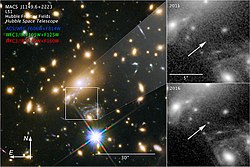 The orbit before and after flyby, with positions on 1 February 2018, before flyby | |
| Discovery [1] | |
|---|---|
| Discovered by | Mount Lemmon Srvy. |
| Discovery site | Mount Lemon Obs. |
| Discovery date | 8 February 2018 (first observed only) |
| Designations | |
| 2018 CN2 | |
| NEO · Apollo [1] [2] Earth- and Mars crosser | |
| Orbital characteristics [2] | |
| Epoch 23 March 2018 (JD 2458200.5) | |
| Uncertainty parameter 7 | |
| Observation arc | 1 day |
| Aphelion | 1.7740 AU |
| Perihelion | 0.6335 AU |
| 1.2037 AU | |
| Eccentricity | 0.4738 |
| 1.32 yr (482 days) | |
| 348.58° | |
| 0° 44m 46.68s / day | |
| Inclination | 25.741° |
| 320.21° | |
| 276.55° | |
| Earth MOID | 7.7×10−5 AU (0.03 LD) |
| Physical characteristics | |
| 5–16 m [3] 9 m(est. at 0.20) [4] 17 m(est. at 0.057) [4] | |
| 27.653 [2] | |
2018 CN2 is a very small asteroid, classified as a near-Earth object of the Apollo group, approximately 5 to 16 meters in diameter. It was first observed by astronomers of the Mount Lemmon Survey at Mount Lemmon Observatory, Arizona, on 8 February 2018, one day prior its close encounter with Earth at 0.18 lunar distances. [1]



